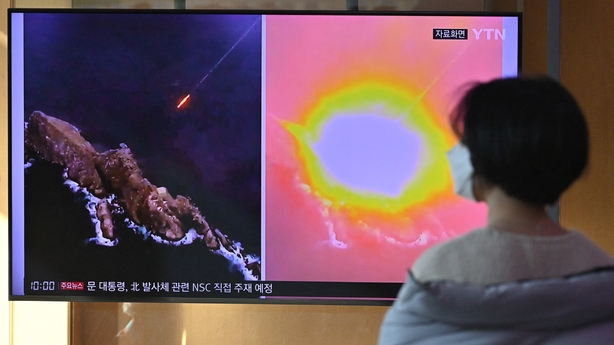North Korea has said it has fired its most powerful missile since 2017, capping a month-long blitz of launches that has raised the spectre of leader Kim Jong-un restarting nuclear tests.
Pyongyang has conducted a record seven weapons tests this January, the most ever in a calendar month, as it threatened to abandon a self-imposed moratorium on launching long-range and nuclear weapons, blaming US "hostile" policy for forcing its hand.
North Korean state media said this morning that the country had test-fired a Hwasong-12 intermediate-range ballistic missile, last launched in 2017, which is powerful enough to put the US territory of Guam in range.
South Korea and the United States responded to the launch with concerns that long-range missiles and nuclear tests could be next on Mr Kim's agenda.
Pyongyang has "come close to destroying the moratorium declaration," South Korean President Moon Jae-in said after an emergency National Security Council meeting Sunday.
He noted the North was showing a "similar pattern" to 2017, when it raised regional tensions by launching intermediate-range missiles and following them up with intercontinental ballistic missile tests.
A senior Biden administration official said Washington shared the concern.
"It's not just what they did yesterday, it's the fact that this is coming on the heels of quite a significant number of tests in this month," he said.

"We obviously don't want to see further testing and we've called upon to DPRK to refrain from further tests," he added, referring to North Korea by the initials of its official name.
South Korea said the Sunday test was of an "intermediate range ballistic missile" that flew around 800km and reached a maximum altitude of 2,000km.
The North's official Korean Central News Agency said the test "confirmed the accuracy, security and effectiveness of the operation of the Hwasong 12-type weapon system under production".
The test was conducted in a manner that ensured the "security of neighbouring countries," KCNA added.
Three reasons why North Korea is firing so many missiles
State media released images purportedly taken by a warhead-mounted camera while it was in space, and others showing the missile blasting off from land. There was no mention of whether Kim Jong-un attended the launch.
In 2017, the launch of the Hwasong-12 was quickly followed by the test-firing of the Hwasong-15, an Intercontinental Ballistic Missile (ICBM) which is powerful enough to hit the US mainland, said Hong Min of the Korea Institute for National Unification.
With yesterday's launch of the Hwasong-12, North Korea is "signaling the possibility of an ICBM launch and an imminent destruction of the moratorium," he said in a note.
With peace talks with Washington stalled, North Korea has doubled down on Mr Kim's vow to modernise the regime's armed forces, flexing Pyongyang's military muscles despite biting international sanctions.
Domestically, North Korea is preparing to celebrate the 80th anniversary of the birth of late leader Kim Jong-il in February, as well as the 110th birthday of founder Kim Il-sung in April.
The string of launches in 2022 comes at a delicate time in the region, with Mr Kim's sole major ally China set to host the Winter Olympics next month and South Korea gearing up for a presidential election in March.

